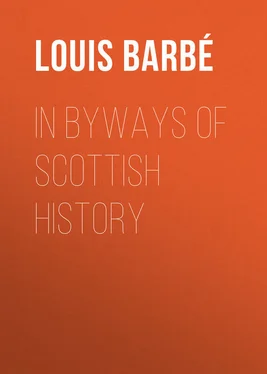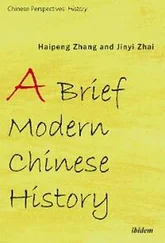Louis Barbé - In Byways of Scottish History
Здесь есть возможность читать онлайн «Louis Barbé - In Byways of Scottish History» — ознакомительный отрывок электронной книги совершенно бесплатно, а после прочтения отрывка купить полную версию. В некоторых случаях можно слушать аудио, скачать через торрент в формате fb2 и присутствует краткое содержание. Жанр: foreign_antique, foreign_prose, на английском языке. Описание произведения, (предисловие) а так же отзывы посетителей доступны на портале библиотеки ЛибКат.
- Название:In Byways of Scottish History
- Автор:
- Жанр:
- Год:неизвестен
- ISBN:нет данных
- Рейтинг книги:4 / 5. Голосов: 1
-
Избранное:Добавить в избранное
- Отзывы:
-
Ваша оценка:
- 80
- 1
- 2
- 3
- 4
- 5
In Byways of Scottish History: краткое содержание, описание и аннотация
Предлагаем к чтению аннотацию, описание, краткое содержание или предисловие (зависит от того, что написал сам автор книги «In Byways of Scottish History»). Если вы не нашли необходимую информацию о книге — напишите в комментариях, мы постараемся отыскать её.
In Byways of Scottish History — читать онлайн ознакомительный отрывок
Ниже представлен текст книги, разбитый по страницам. Система сохранения места последней прочитанной страницы, позволяет с удобством читать онлайн бесплатно книгу «In Byways of Scottish History», без необходимости каждый раз заново искать на чём Вы остановились. Поставьте закладку, и сможете в любой момент перейти на страницу, на которой закончили чтение.
Интервал:
Закладка:
Of Mary Livingston's life after the death of her husband but little is known. From an Act of Parliament passed in November, 1581, it appears that tardy justice was done her by James VI, who caused the grants formerly made to "umquhile John Semple, of Butress, and his spouse, to be ratified". Her eldest son, James, was brought up with James VI, and in later life was sent as ambassador to England. He was knighted in 1601. There were three other children – two boys, Arthur and John, and one girl, Dorothie.
The exact date of Mary Livingston's death is not known, but she appears to have been living in 1592.
MARY BETON
The family to which Mary Beton, or, as she herself signed her name, Marie Bethune, belonged, seems to have been peculiarly devoted to the service of the house of Stuart. Her father, Robert Beton, of Creich, is mentioned amongst the noblemen and gentlemen who sailed from Dumbarton with the infant Queen, in 1548, and who accompanied her in 1561, when she returned to take possession of the Scottish throne. His office was that of one of the Masters of the Household, and, as such, he was in attendance at Holyrood when the murderers of Rizzio burst into the Queen's chamber and stabbed him before her eyes. He also appears under the style of Keeper of the Royal Palace of Falkland, and Steward of the Queen's Rents in Fife. At his death, which occurred in 1567, he recommends his wife and children to the care of the Queen, "that scho be haill mantenare of my hous as my houpe is in hir Maiestie under God". His grandfather, the founder of the house, was comptroller and treasurer to King James IV. His aunt was one of the ladies of the court of King James V, by whom she was the mother of the Countess of Argyll. One of his sisters, the wife of Arthur Forbes of Reres, stood high in favour with Queen Mary, and was wet-nurse to James VI. His French wife, Jehanne de la Runuelle, and two of his daughters, were ladies of honour.
Of the four Marys, Mary Beton has left least trace in the history of the time. It seems to have been her good fortune to be wholly unconnected with the political events which, in one way or another, dragged her fair colleagues into their vortex, and it may be looked upon as a proof of the happiness of her life, as compared with their eventful careers, that she has but little history.
Though but few materials remain to enable us to reconstruct the story of Mary Beton's life, a fortunate chance gives us the means of judging of the truth of the high-flown compliments paid to her beauty by both Randolph and Buchanan. A portrait of her is still shown at Balfour House, in Fife. It represents, we are told, "a very fair beauty, with dark eyes and yellow hair", and is said to justify all that has been written in praise of her personal charms. 91The first to fall a victim to these was the English envoy, Randolph. A letter of his to the Earl of Bedford, written in April, 1565, mentions, as an important fact, that Mistress Beton and he had lately played a game at biles against the Queen and Darnley, that they had been successful against their royal opponents, and that Darnley had paid the stakes. 92In another letter, written to Leicester, he thinks it worthy of special record that for four days he had sat next her at the Queen's table, at St. Andrews. "I was willed to be at my ordinary table, and being placed the next person, saving worthy Beton, to the Queen herself." Writing to the same nobleman he makes a comparison between her and Mary Fleming, of whom, as we have seen, he had drawn so glowing a description, and declares that, "if Beton had lyked so short a time, so worthie a rowme, Flemyng to her by good right should have given place". 93Knowing, as we do, from the testimony of other letters, how prone Randolph was to overrate his personal influence, and with what amusing self-conceit he claimed for himself the special favours of the ladies of the Scottish Court, there is every reason to suspect the veracity of the statement contained in the following extract from a letter to Sir Henry Sidney: "I doubt myself whether I be the self-same man that now will be content with the name of your countryman, that have the whole guiding, the giving, and bestowing, not only of the Queen, and her kingdom, but of the most worthy Beton, to be ordered and ruled at mine own will".
Like her colleague, Mary Fleming, "the most worthy Beton" had her hour of mock royalty, as we learn from three sets of verses in which Buchanan extols her beauty, worth, and accomplishments, and which are inscribed: "Ad Mariam Betonam pridie Regalium Reginam sorte ductam". In the first of these, which bears some resemblance to that addressed to Mary Fleming on a similar occasion, he asserts, with poetical enthusiasm, the mimic sovereign's real claims to the high dignity which Fortune has tardily conferred upon her: —
Princely in mind and virtue, and so fair,
You've long seemed fit a diadem to wear;
And Fortune, blushing to have stood aloof,
Now lavishes her gifts to your behoof;
Deeming atonement for her tardiness
Demands in justice she should do no less,
She brings the Queen whom all the rest obey
A willing subject to your sovereign sway.
In his next effusion the poet rises to a more passionate height in his admiration. It is such as we might imagine Randolph to have penned in his enthusiasm, could we, by any flight of fancy, suppose him capable of such scholarly verses as those of Buchanan: —
Should I rejoice, or should my heart despair,
That Beton's yoke the Fates have made me bear?
O, Comeliness, what need have I of thee,
When hope of mutual love is dead for me?
For favours such as these, in life's young day,
E'en life had seemed no heavy price to pay;
And though my earthly bliss had been but brief,
Its fulness would have soothed my dying grief;
Now, ling'ring fires consume; I lack life's joy,
And death would bring me comfort, not annoy;
In life, in death, be this my comfort still,
That life and death are at my Lady's will.
The third epigram is more particularly interesting, as bearing reference, we think, to Mary Beton's literary tastes: —
Beneath cold Winter's blast the fields are bare,
Nor yield a posy for my Lady fair;
E'en so my Muse, luxuriant in her prime,
Has felt the chill and numbing grip of time;
Could lovely Beton's spirit but inspire,
'Twere Spring again, with all its life and fire.
The will drawn up by Mary Stuart, in 1556, which, it is true, never took effect, seems to point to Mary Beton as the most scholarly amongst the maids of honour. It is to her that the French, English, and Italian books in the royal collection are bequeathed; the classical authors being reserved for the University of St. Andrews, where they were intended to form the nucleus of a library: "Je laysse mes liuures qui y sont en Grec ou Latin à l'université de Sintandre, pour y commencer une bible. Les aultres ie les laysse à Beton." 94
This is further borne out by the fact that, many years later, William Fowler, secretary to Queen Anne of Denmark, wife of James VI, dedicated his "Lamentatioun of the desolat Olympia, furth of the tenth cantt of Ariosto" "to the right honourable ladye Marye Betoun, Ladye Boine". Of the literary accomplishments which may fairly be inferred from these circumstances, we have, however, no further proof. Nothing of Mary Beton's has come down to us, except a letter, addressed by her in June, 1563, to the wife of Sir Nicholas Throckmorton, whose acquaintance she may have made either in France or in Scotland, Sir Nicholas having been English Ambassador in both countries. In this short document the writer acknowledges the receipt of a ring, assures the giver that she will endeavour to return her love by making her commendations to the Queen, and begs her acceptance in return, and as a token of their good love and amity, of a little ring which she has been accustomed to wear daily. 95
Читать дальшеИнтервал:
Закладка:
Похожие книги на «In Byways of Scottish History»
Представляем Вашему вниманию похожие книги на «In Byways of Scottish History» списком для выбора. Мы отобрали схожую по названию и смыслу литературу в надежде предоставить читателям больше вариантов отыскать новые, интересные, ещё непрочитанные произведения.
Обсуждение, отзывы о книге «In Byways of Scottish History» и просто собственные мнения читателей. Оставьте ваши комментарии, напишите, что Вы думаете о произведении, его смысле или главных героях. Укажите что конкретно понравилось, а что нет, и почему Вы так считаете.












